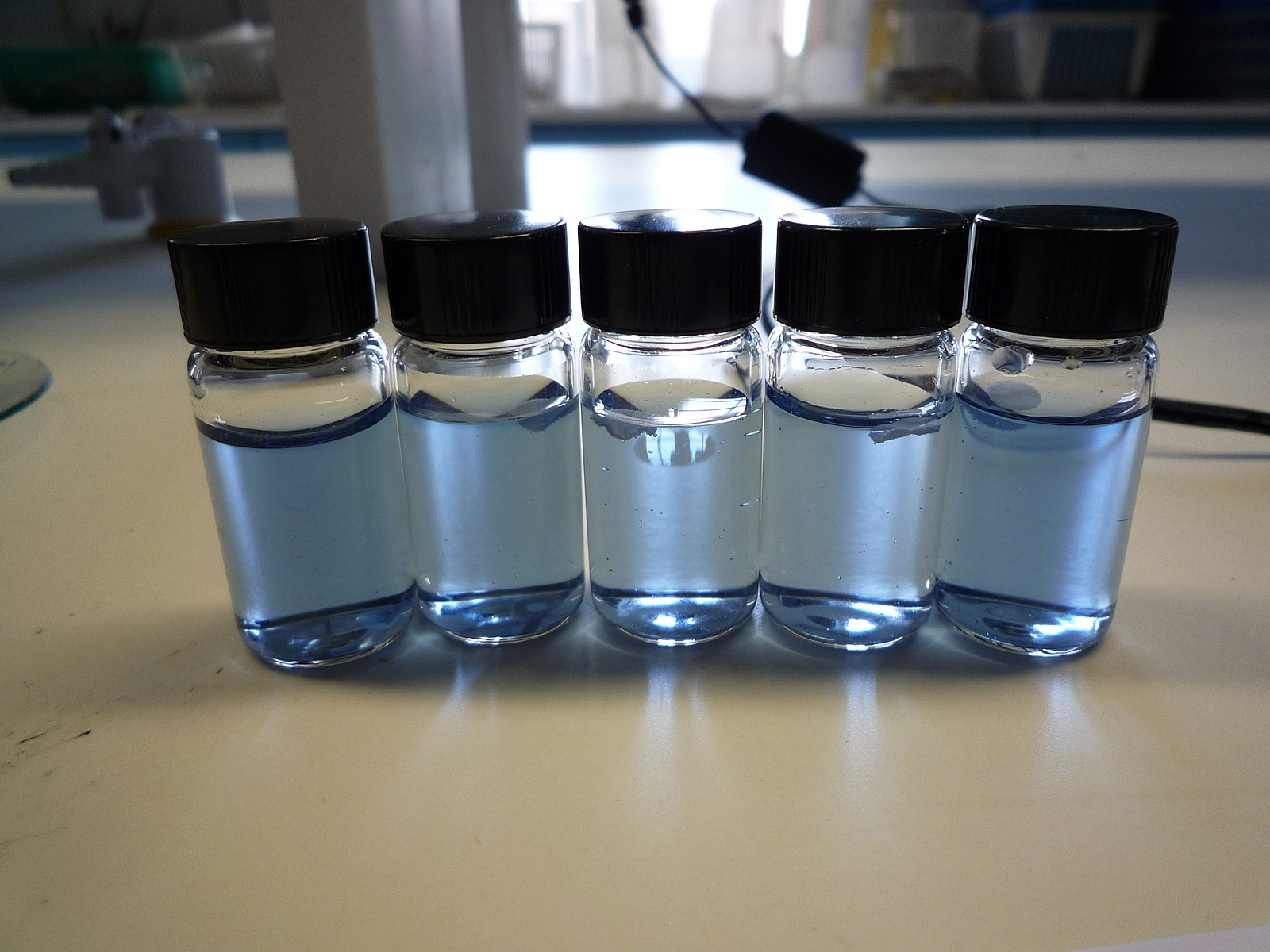Step 1
Crush two 1000 mg (2 g) vitamin C tablets with the back of the tablespoon.
Step 2
Transfer the crushed tablets into a glass and add 60 mL of distilled water, while stirring the mixture. It is important that distilled water is used and not tap water.
Step 3
Place a couple of coffee filters in a funnel and place the funnel into a glass.
Step 4
Pour the solution of the crushed tablets and water, prepared in step 2, into the funnel, and through the filter papers. Collect the resulting filtrate in a glass, Label the glass ‘A’.
Step 5
Heat about 350 mL of water and transfer this into another glass.
Step 6
Add 0.4 g of cornstarch to the hot water with constant stirring. It is essential that hot water is used as it is difficult to dissolve the cornstarch in cold water. http://digitalcommons.unl.edu/cgi/viewcontent.cgi?article=1118&context=foodsciefacpub
Step 7
Replace the coffee filters in the funnel and place this in a third glass.
Step 8
Pour into the funnel the solution prepared in step 6, collect the filtrate and label the glass ‘B’.
Step 9
Add 150 mL of 3% hydrogen peroxide to the glass labeled ‘B’.
Step 10
Add 25 mL of 5% iodine tincture (alcohol extract) to the glass labelled ‘A’ and swirl the glass until the liquid becomes colourless.
Step 11
Add 300 mL of water to the glass labelled ‘A’.
Step 12
In a glass, add equal amounts of the liquids from the glass ‘A’ and glass ‘B’.
Step 13
Note the time taken for the colour change to be observed.
Step 14
Place the two labelled glasses with the remaining liquid in an ice-bath and allow to cool for five minutes. Repeat step 12 and 13.
You can use orange juice, which is rich in vitamin C, instead of using tablets. The change in colour observed would be from orange to blue-black.
3% hydrogen peroxide is relatively safe to use but precautions should still be taken, especially if at higher concentrations. Hydrogen peroxide can cause skin, eye and respiratory irritation. If in contact with eye, rinse cautiously with water for several minutes and remove contact lenses. It may also intensify fire. Avoid direct skin contact https://pubchem.ncbi.nlm.nih.gov/compound/784#section=Safety-and-Hazards
Iodine tincture: Can cause skin, eye and respiratory irritation. If in contact with eye, rinse cautiously with water for several minutes and remove contact lenses. Avoid direct skin contact. https://pubchem.ncbi.nlm.nih.gov/compound/807#section=GHS-Classification
Take care when handling iodine to avoid inadvertent staining.
A chemical reaction occurs when two atoms collide with each other with enough force to change both atoms at a molecular level, how quickly a reaction happens depends on how often these collisions happen and if they collide with enough force. So two factors that can change how quickly a reaction happens depends on how much of the reactants there are and how quickly they are moving. Atoms move randomly in a system, bouncing off walls until they collide with another reactant, therefore increasing the concentration of either reactant will result in more collisions. How much energy these atoms move with, depends on the temperature they are at, the hotter the temperature, the greater energy the energy within the atoms, and the fast they move, therefore increasing the temperature increases the rate of a reaction. Imagine the bumper cars at a fairground, if there are not many cars in the ring and they are only able to move very slowly, the number of collisions will be low. If you add more bumper cars and increase the speed that they can go with, you will have a greater number of collisions. It is the same in chemistry, and with more collisions, the more likely the atoms will react with each other.
Why does it take several seconds for the colour to be observed?
This is the time taken for all the Vitamin C to be exhausted, when there is no more Vitamin C, Iodine can start to accumulate
Why is the colour observed blue-black?
Black is the characteristic colour of the starch-iodine complex formed.
Why does the colour change occur all at once?
It actually does not occur all at once, but in pockets which eventually merge together.
What would happen if the concentration of Vitamin C was increased or decreased?
The time required for a change in colour is longer or reduced respectively.
What would happen if the amount of iodine added is increased?/strong>
The blue-black colour takes less time to appear.
What would happen if the temperature of reaction mixture was increased?
The reaction occurs faster, hence, colour change is observed in a shorter period of time.
The iodine clock reaction is a simple experiment where two colourless mixtures are added together and then they suddenly change into a blue-black colour after a precise period of time.
There are two reactions occurring in this experiment, vitamin C resting with the iodine to create iodide, and the iodide reacting with the hydrogen peroxide. The reaction between vitamin C and iodine happens much quicker than the other reaction, so you have to wait for the vitamin C to be used up before we can observe the effects of the second reaction.
The black colour observed is due an interaction between iodine and starch. It is only the iodine (I2) that is able to produce a blue-black solution upon interacting with starch. The iodine present in the solution is rapidly converted into the iodide by vitamin C. Therefore, at the start of the experiment the colour change can not occur as this requires iodine to react with the starch. Once the Vitamin C has been used up, the iodide can be converted back to iodine by the hydrogen peroxide and when enough iodine is present a complex can be formed with the starch, causing the colour of the solution will change to blue-black.
Oxidation of iodide results in molecular iodine or into tri-iodide ions. If the concentration of iodine is sufficient upon combining with starch, a blue-black colour is produced due to the presence of a starch-iodine complex. In such an experiment, the retardation of the blue-black colour is due to the presence of a reducing agent that does not allow the iodine to accumulate.
The iodine present in the solution is quickly reduced to iodide by vitamin C. This is the rate-determining step as this reduction step occurs at a faster rate than the oxidation step by which the iodide is oxidised into iodine. The iodine is not allowed to accumulate, hence, the blue-black colour is not observed. For the colour to be detected by the naked eye, the concentration needs to be greater than 10-5 mol/L. The reduction and the oxidation reactions are as follows:

The concentration of the reagents used is set in a way for the vitamin C to be the limiting reagent and thus gets exhausted before the hydrogen peroxide. Once the vitamin C is fully consumed, the hydrogen peroxide converts the iodide into iodine. Since reduction is no longer occurring, the iodine starch can combine and the dark blue colour is produced. http://pubs.acs.org.ejournals.um.edu.mt/doi/pdf/10.1021/ed079p40A
As observed by the naked eye, the black colour appears throughout the entire solution all at once. However, observing the reaction in slow motion, the colour starts to appear at spots at different points within the solution and these spots increase in size to gradually merge into one another. This occurs because when solution A and solution B are mixed together, the mixing is not perfect, which results in areas to be higher in the concentration of a particular reagent. https://www.youtube.com/watch?v=KWJpKNQfXWo
The rate at which this reaction occurs depends on the concentration of iodine and of vitamin C as well as the temperature results, this is an example of kinetics. The time taken for the blue-black colour to appear is inversely proportional to the concentration of the iodine ions and to the temperature. That is the greater the concentration or the temperature, the less the time needed for the complex product to appear. Whereas an increase in the vitamin C concentration causes a delay in the appearance of the colour as the cycle of the redox reactions occurs for a prolonged period of time.
Chemistry and chemical reactivity by Kotz, Treichel & Townsend.
Applications
The iodine clock reaction is especially important due to its unique thermodynamic properties. It is a perfect example for the explanation and understanding of the principle of kinetics, and the direct influence of the concentration and temperature on the rate of a chemical reaction.
Kinetics allow for predictions to be made on the change in quality of food, based on time and also on environmental conditions. By analysing the major processes causing deterioration, the prediction of quality loss is achieved. This knowledge can be used to increase the shelf life of food. Such studies are especially important for food industries to be able to print an expiration date of the product and analyse the influence an additive or a new ingredient has on shelf life. http://pubs.acs.org.ejournals.um.edu.mt/doi/pdf/10.1021/ed061p348
Research
A huge interest is focused on reducing our high dependency on fossil fuels into a more reusable energy. Replacing diesel with biodiesel is one considered option as it’s considered a greener source of energy, however, production of biodiesel on a large scale turns out to be rather expensive. Therefore, research into various kinetic models are being used for the esterification mechanism that convert disposal oils and fats into biodiesel. Mainly, the use of either homogeneous or heterogeneous acid catalysts is being considered using developed mathematical kinetic models to report the esterification process. https://link.springer.com/article/10.1007/s11144-015-0848-x
- Keep the same conditions as described in the method but vary the amount of vitamin C used. For example using 1, 2 or 4 tablets of 1000 mg (1 gram) of Vitamin C and then observing the effects of these changes on the time it takes for the blue-black colour to appear.
- Alter the amount of starch used, for instance using either 0.8 g and 1.2 g of cornstarch. Monitor if this changes the rate of reaction.
- Test the importance of hydrogen peroxide on the rate of reaction. This can be investigated by changing the volume of hydrogen peroxide used to conduct the experiment, such as using 100 mL or 200 mL of hydrogen peroxide and note the change in the rate of reaction.
- Changing the amount of iodine tincture added is also going to influence the rate. Simply test this out by varying the amount of iodine added. Therefore, add 15 mL or 50 mL of iodine and notice how this influences the time taken for the change in colour to occur.




